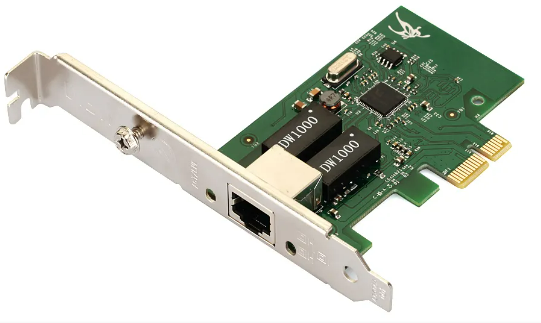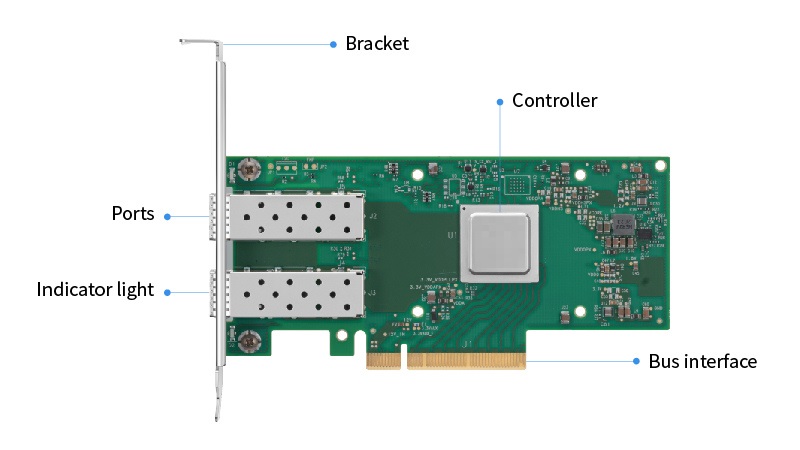What Is a Network Interface Card?
To connect and transmit data or information both locally and globally, we rely on various computer networks like LAN, MAN, or WAN. But if I were to ask which hardware component your computer needs to connect to these networks, most people might not know the answer. The essential hardware is called a Network Interface Card (NIC).

ad
What is a NIC card?
A NIC (network interface controller) card, also known as a network adapter or network interface card, is a circuit board installed in a computer to enable network connectivity.
A NIC card is essential for establishing a network connection on computers, facilitating better communication between data communication equipment (DCE).
NIC cards are commonly present in most computers and some network servers. They include electrical circuitry that complies with data link and physical layer standards, along with a port for connecting to the local area network’s (LAN) medium.
ad
Each device (node) on a LAN must have at least one NIC card to communicate.
How does a NIC card work?
When functioning as a link a NIC card can send signals on the level and transfer data packets, on the network level.
No matter where it is placed the NIC card serves as a mediator between a computer or server and a data network.
Whenever a user asks for a webpage the LAN card retrieves data from the users device transmits it to the server over the Internet. Receives back the information, from the Internet to show to users.
Where is a NIC located on a computer?
It depends. Originally, network interface cards were connected to a computer via an expansion card that plugged into the computer bus. When building a computer, you would buy the NIC separately and install it in one of the slots. However, as Ethernet became the standard for data transfer in networks, motherboard manufacturers began integrating the NIC directly into the motherboard, either within the motherboard chipset or through a dedicated Ethernet chip.
A NIC may still be installed in a motherboard slot, especially if the computer needs to connect to a non-Ethernet network. NICs can also be portable and connect via USB.
Components of Network Interface Card
A NIC card consists of six main components:
- Controller: The controller functions like a mini CPU, processing the data it receives. As a crucial part of a network adapter, the controller directly influences the performance of the NIC.
- Boot ROM (Read-only memory) Socket: This socket on the card enables boot ROM capability, which permanently stores instructions for the computer. Boot ROM allows diskless workstations to connect to the network, enhancing security and reducing hardware costs.
- NIC Port for Cable/Transceiver: This port typically connects with an Ethernet cable to the transceiver, which can generate and receive the electronic signals transmitted through the network or fiber cable.
- BUS Interface: Located on the side of the circuit board, this interface connects the NIC to the computer or server by plugging into an expansion slot.
- LED Indicators: These indicators help users identify the working status of the network card, showing whether the card is connected to the network.
- Profile Bracket: There are two types of profile brackets available: the full-height bracket, which is 12 cm long, and the low-profile bracket, which is 8 cm long. This bracket helps secure the NIC in the expansion slot of a computer or server.

What are the types of NIC cards?
NIC cards are categorized based on various features such as host interface, transmission speed, and application fields. Here are the five different types of classifications:
1. Network Connection-Based Classifications
- Wired NIC: Connects a node to a network using an Ethernet or fiber optic cable.
- Wireless NIC: Comes with a small antenna that uses radio waves to communicate with the access point for wireless network connection.
2. Bus Interface-Based Classifications
- ISA (Industry Standard Architecture): Developed in 1981, this standard bus architecture for IBM compatibles is now obsolete due to its low speed of 9 Mbps and is rarely found today.
- PCI (Peripheral Component Interconnect): Introduced in 1990 to replace ISA, with a fixed width of 32-bit and 64-bit, initially used in servers and later in PCs. It has largely been replaced by newer interfaces like PCI-X or USB.
- PCI-X (Peripheral Component Interconnect eXtended): An enhanced version of PCI, operating at 64-bit and supporting up to 1064 MB/s, often backward compatible with PCI NIC cards.
- PCIe (Peripheral Component Interconnect Express): The latest standard, widely used in modern computer and server motherboards, available in five versions with different lanes and speeds.
- USB (Universal Serial Bus): An external bus standard with three versions offering different data rates, compatible with various devices. Wireless NICs also fall under this category.
3. Port Type-Based Classifications
- RJ-45 Port: Used for connecting with twisted pair cables.
- AUI Port: Used for thick coaxial cables.
- BNC Port: Used for thin coaxial cables.
- Optical Port: Used for transceivers.
4. Transmission Speed-Based Classifications
- 10 Mbps, 100 Mbps, and 10/100 Mbps Adaptive Cards: Suitable for small LANs, home use, or day-to-day office work.
- 1000 Mbps NIC Cards: Provide higher bandwidth for Gigabit networks.
- 10GbE, 25Gb, or Higher-Speed NIC Cards: Used by large enterprises or data centers for high-speed data transmission.
5. Application Field-Based Classifications
- Computer NIC Card: Most modern computers have integrated NIC cards on the motherboard, typically supporting speeds of 10/100 Mbps or 1 Gbps, enabling communication with other PCs or networks.
- Server Network Card: Designed to manage and handle network traffic with higher transmission speeds like 10G, 25G, 40G, or even 100G. Server adapters have a low CPU occupancy rate due to a dedicated network controller that offloads tasks from the CPU.
- SmartNICs: A type of NIC card that offloads tasks from the host server’s CPU, reducing workloads and offering additional features like enhanced security and storage.
Advantages of NIC
A NIC offers several advantages, including:
- Cost-Effective: Affordable to purchase and install.
- Secure Connection: Provides a secure link between the device and the cable.
- Data Sharing: Allows multiple users to share or transfer large amounts of data.
- Reliable Connectivity: Ensures highly dependable connections between nodes.
- High Data Rates: Newer NICs can achieve data rates of up to 2000 Mbps.
- Fast Internet Speed: Transmission speeds are very high, often measured in gigabytes.
- Multiple Ports: Supports several peripherals through its multiple ports.
Disadvantages of NIC
While NICs offer many advantages, they also have some disadvantages, including:
- Security: Security can be somewhat inadequate.
- Volatility: Information can be volatile.
- Speed Upgrades: Replacement may be needed to support higher speeds.
- Configuration: Precise settings are necessary for optimal communication.
- Portability: Wired NICs are less convenient and not as portable as wireless routers.
FAQ’s
What is a NIC card?
A NIC (Network Interface Card) is a circuit board that allows a computer to connect to a network. It enables data transfer between the computer and other network devices.
How does a NIC card work?
A NIC card sends and receives data packets over a network. It retrieves data from a user’s device, sends it to the server via the Internet, and displays the returned information.
Where is a NIC located on a computer?
NICs can be integrated into the motherboard, installed in an expansion slot, or connected via USB.
What are the main components of a NIC card?
Key components include the controller (processes data), boot ROM socket (stores instructions), NIC port (connects cables), BUS interface (links to the motherboard), LED indicators (show connection status), and profile bracket (secures the NIC).
What are the types of NIC cards?
NIC cards vary by network connection (wired or wireless), bus interface (ISA, PCI, PCI-X, PCIe, USB), port type (RJ-45, AUI, BNC, Optical), transmission speed, and application (computer NICs, server network cards, SmartNICs).
Conclusion
Network Interface Cards (NICs) are essential for connecting computers to networks, whether wired or wireless. They enable efficient data transfer and come in various types to suit different needs. While they offer benefits like cost-effectiveness and high-speed connections, NICs also have some limitations, such as security concerns and the need for upgrades. Knowing these factors helps in selecting the right NIC for your network requirements.
ad


Comments are closed.